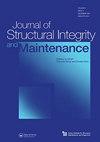Study of the aerodynamic damping of wing plates on traffic signal structures based on the 2D one-way FSI analysis
IF 3.1
Q2 ENGINEERING, CIVIL
Journal of Structural Integrity and Maintenance
Pub Date : 2021-10-02
DOI:10.1080/24705314.2021.1902662
引用次数: 0
Abstract
ABSTRACT To improve the fatigue performance of these traffic signs, luminaries and signals structures, the wing plate, a type of aerodynamic damper, is adopted to control the dynamic responses due to wind-induced fatigue load. In this study, one-way 2D fluid-structure interaction (FSI) analysis is conducted to investigate the mitigation ability of the wing plate. Parametric study is involved to investigate the influence on the damping effect caused by the different configuration of the wing plate, as well as the wind speed. The different configurations of signals and signs applied in Maryland, USA, have been studied to find the potential aerodynamic instability due to galloping. The required length of wing plate for the 23-m mast-arm signal structure in Maryland have been analyzed. The study shows that small space between the wing plate and the arm will reduce the mitigation ability. Wing plate may lose mitigation ability due to stalling. Large vortex shedding is observed in the FSI analysis. The wing plate with dimension 610 mm × 610 mm applied by PennDOT can effectively prevent galloping for signal pole structures in Maryland. This research can be used as a reference for the selection of mitigation devices to satisfy the “effective mitigation devices” stated by AASHTO.基于二维单向FSI分析的交通信号结构翼板气动阻尼研究
摘要:为了改善交通标志、照明灯和信号结构的疲劳性能,采用翼板气动阻尼器控制其在风致疲劳荷载作用下的动力响应。本研究采用单向二维流固耦合分析(FSI)研究翼板的减振能力。通过参数化研究,考察了不同翼板构型和风速对阻尼效果的影响。研究了在美国马里兰州应用的不同配置的信号和标志,以发现由于飞奔而潜在的空气动力学不稳定性。分析了马里兰州23m桅杆臂信号结构所需翼板长度。研究表明,翼板与臂之间的空间过小会降低减振能力。翼板可能因失速而失去减缓能力。在FSI分析中观察到较大的涡脱落。PennDOT应用的尺寸为610 mm × 610 mm的翼板可以有效地防止马里兰州信号杆结构的飞奔。本研究可为缓解装置的选择提供参考,以满足AASHTO提出的“有效缓解装置”。
本文章由计算机程序翻译,如有差异,请以英文原文为准。
求助全文
约1分钟内获得全文
求助全文
来源期刊

Journal of Structural Integrity and Maintenance
ENGINEERING, CIVIL-
CiteScore
3.90
自引率
9.50%
发文量
24
 求助内容:
求助内容: 应助结果提醒方式:
应助结果提醒方式:


